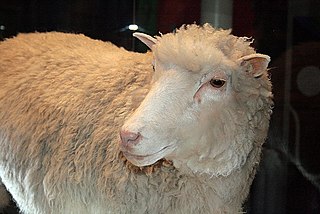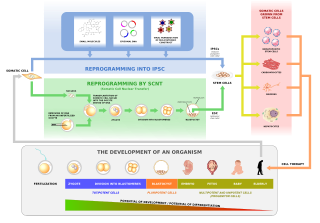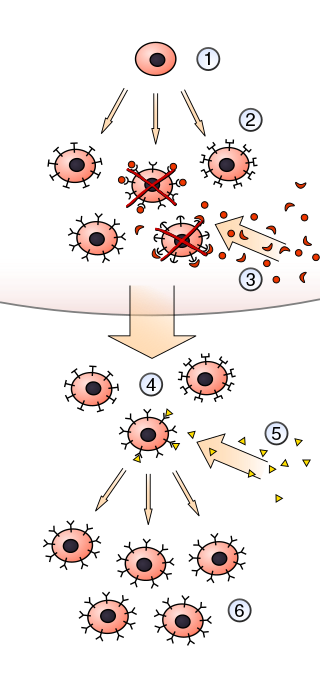Related Research Articles

Cloning is the process of producing individual organisms with identical genomes, either by natural or artificial means. In nature, some organisms produce clones through asexual reproduction; this reproduction of an organism by itself without a mate is known as parthenogenesis. In the field of biotechnology, cloning is the process of creating cloned organisms of cells and of DNA fragments.

Dolly was a female Finn-Dorset sheep and the first mammal that was cloned from an adult somatic cell. She was cloned by associates of the Roslin Institute in Scotland, using the process of nuclear transfer from a cell taken from a mammary gland. Her cloning proved that a cloned organism could be produced from a mature cell from a specific body part. Contrary to popular belief, she was not the first animal to be cloned.

Human cloning is the creation of a genetically identical copy of a human. The term is generally used to refer to artificial human cloning, which is the reproduction of human cells and tissue. It does not refer to the natural conception and delivery of identical twins. The possibilities of human cloning have raised controversies. These ethical concerns have prompted several nations to pass laws regarding human cloning.

A genetic chimerism or chimera is a single organism composed of cells with more than one distinct genotype. In animals and human chimeras, this means an individual derived from two or more zygotes, which can include possessing blood cells of different blood types, and subtle variations in form (phenotype). Animal chimeras are produced by the merger of two embryos. In plant chimeras, however, the distinct types of tissue may originate from the same zygote, and the difference is often due to mutation during ordinary cell division. Normally, genetic chimerism is not visible on casual inspection; however, it has been detected in the course of proving parentage. In contrast, an individual where each cell contains genetic material from two organisms of different breeds, varieties, species or genera is called a hybrid.

In genetics and developmental biology, somatic cell nuclear transfer (SCNT) is a laboratory strategy for creating a viable embryo from a body cell and an egg cell. The technique consists of taking an denucleated oocyte and implanting a donor nucleus from a somatic (body) cell. It is used in both therapeutic and reproductive cloning. In 1996, Dolly the sheep became famous for being the first successful case of the reproductive cloning of a mammal. In January 2018, a team of scientists in Shanghai announced the successful cloning of two female crab-eating macaques from foetal nuclei.

Sir John Cowdery Kendrew, was an English biochemist, crystallographer, and science administrator. Kendrew shared the 1962 Nobel Prize in Chemistry with Max Perutz, for their work at the Cavendish Laboratory to investigate the structure of haem-containing proteins.
The year 1984 in science and technology involved some significant events.
Commercial animal cloning is the cloning of animals for commercial purposes, including animal husbandry, medical research, competition camels and horses, pet cloning, and restoring populations of endangered and extinct animals. The practice was first demonstrated in 1996 with Dolly the sheep.

Nuclear transfer is a form of cloning. The step involves removing the DNA from an oocyte, and injecting the nucleus which contains the DNA to be cloned. In rare instances, the newly constructed cell will divide normally, replicating the new DNA while remaining in a pluripotent state. If the cloned cells are placed in the uterus of a female mammal, a cloned organism develops to term in rare instances. This is how Dolly the Sheep and many other species were cloned. Cows are commonly cloned to select those that have the best milk production. On 24 January 2018, two monkey clones were reported to have been created with the technique for the first time.
Tetra is a rhesus macaque that was created through a cloning technique called "embryo splitting". She is the first "cloned" primate by artificial twinning, and was created by a team led by Professor Gerald Schatten of the Oregon National Primate Research Center.

In immunology, clonal selection theory explains the functions of cells of the immune system (lymphocytes) in response to specific antigens invading the body. The concept was introduced by Australian doctor Frank Macfarlane Burnet in 1957, in an attempt to explain the great diversity of antibodies formed during initiation of the immune response. The theory has become the widely accepted model for how the human immune system responds to infection and how certain types of B and T lymphocytes are selected for destruction of specific antigens.
A frozen zoo is a storage facility in which genetic materials taken from animals are stored at very low temperatures (−196 °C) in tanks of liquid nitrogen. Material preserved in this way can be stored indefinitely and used for artificial insemination, in vitro fertilization, embryo transfer, and cloning. There are a few frozen zoos across the world that implement this technology for conservation efforts. Several different species have been introduced to this technology, including the Pyrenean ibex, Black-footed ferret, and potentially the white rhinoceros.
Keith Henry Stockman Campbell was a British biologist who was a member of the team at Roslin Institute that in 1996 first cloned a mammal, a Finnish Dorset lamb named Dolly, from fully differentiated adult mammary cells. He was Professor of Animal Development at the University of Nottingham. In 2008, he received the Shaw Prize for Medicine and Life Sciences jointly with Ian Wilmut and Shinya Yamanaka for "their works on the cell differentiation in mammals".

David Jay Julius is an American physiologist and Nobel Prize laureate known for his work on molecular mechanisms of pain sensation and heat, including the characterization of the TRPV1 and TRPM8 receptors that detect capsaicin, menthol, and temperature. He is a professor at the University of California, San Francisco.

Gábor Vajta is a medical doctor, human pathologist and mammalian embryologist living in Cairns, Queensland, Australia. Vajta was an Honorary Professor of the BGI College, Shenzhen, China, and Adjunct Professor of the Central Queensland University, Rockhampton, Queensland, Australia. After an early career in human pathology he turned to embryology in 1989 and obtained a Doctor of Science degree in Domestic Animal Embryology at the Royal Veterinary and Agricultural University in Copenhagen, Denmark in 1999. During the past 25 years he has co-developed several patents relating to embryology, most notably the method of Handmade Cloning (HMC), the Submarine Incubation System (SIS), the Open Pulled Straw (OPS) vitrification and the Well of the Well (WOW) system. Currently Professor Vajta is director of a consulting company providing services in human and domestic animal embryology all over the world, and founder and Chief Scientific Officer of VitaVitro Biotech Co., Ltd., Shenzhen, China.
Shoukhrat Mitalipov is an American biologist who heads the Center for Embryonic Cell and Gene Therapy at the Oregon Health & Science University in Portland. He is a well known pioneer of many nuclear transplantation studies and was named in 2013 by journal Nature as "the cloning chief". Mitalipov is also a godfather of a gene therapy, known as mitochondrial replacement therapy, that prevents inheritance of mitochondrial diseases. He discovered a new way of creating human stem cells from skin cells.

Zhong Zhong and Hua Hua are a pair of identical crab-eating macaques that were created through somatic cell nuclear transfer (SCNT), the same cloning technique that produced Dolly the sheep in 1996. They are the first cloned primates produced by this technique. Unlike previous attempts to clone monkeys, the donated nuclei came from fetal cells, not embryonic cells. The primates were born from two independent surrogate pregnancies at the Institute of Neuroscience of the Chinese Academy of Sciences in Shanghai.
Nature's 10 is an annual listicle of ten "people who mattered" in science, produced by the scientific journal Nature. Nominees have made a significant impact in science either for good or for bad. Reporters and editorial staff at Nature judge nominees to have had "a significant impact on the world, or their position in the world may have had an important impact on science". Short biographical profiles describe the people behind some of the year's most important discoveries and events. Alongside the ten, five "ones to watch" for the following year are also listed.
The Hwang affair, or Hwang scandal, or Hwanggate, is a case of scientific misconduct and ethical issues surrounding a South Korean biologist, Hwang Woo-suk, who claimed to have created the first human embryonic stem cells by cloning in 2004. Hwang and his research team at the Seoul National University reported in the journal Science that they successfully developed a somatic cell nuclear transfer method with which they made the stem cells. In 2005, they published again in Science the successful cloning of 11 person-specific stem cells using 185 human eggs. The research was hailed as "a ground-breaking paper" in science. Hwang was elevated as "the pride of Korea", "national hero" [of Korea], and a "supreme scientist", to international praise and fame. Recognitions and honours immediately followed, including South Korea's Presidential Award in Science and Technology, and Time magazine listing him among the "People Who Mattered 2004" and the most influential people "The 2004 Time 100".
References
- ↑ Reproduction, Fertility and Development 2005, 17
- ↑ Willadsen, Steen M. (1986-03-06). "Nuclear transplantation in sheep embryos". Nature. 320 (6057): 63–65. doi:10.1038/320063a0. ISSN 1476-4687.
- ↑ Willadsen, Steen M. (1989-01-15). "Cloning of sheep and cow embryos". Genome. 31 (2): 956–962. doi:10.1139/g89-167. ISSN 0831-2796.
- ↑ Willadsen, Steen M. (January 1977). Elliott, Katherine; Whelan, Julie (eds.). "Factors affecting the survival of sheep embryos during deep-freezing and thawing". Novartis Foundation Symposia. 52: 175–201. doi:10.1002/9780470720332.ch9. ISBN 978-0-85708-010-3.
- ↑ Willadsen, Steen M. (1979-01-25). "A method for culture of micromanipulated sheep embryos and its use to produce monozygotic twins". Nature. 277 (5694): 298–300. doi:10.1038/277298a0. ISSN 0028-0836.
- ↑ Fehilly, Carole B.; Willadsen, Steen M.; Tucker, Elizabeth M. (1984-02-16). "Interspecific chimaerism between sheep and goat". Nature. 307 (5952): 634–636. doi:10.1038/307634a0. ISSN 0028-0836.